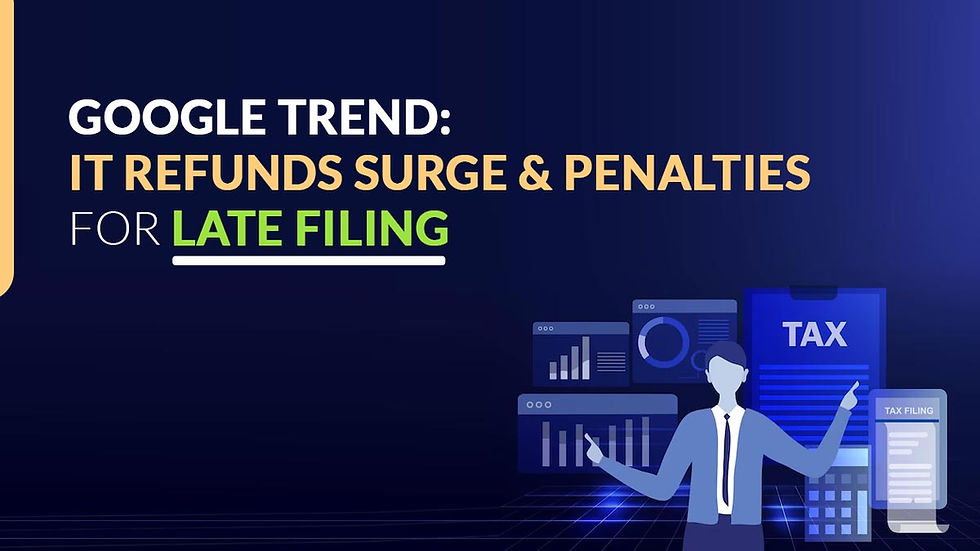What to Do If You Receive a GST SCN U/S 16(4)? Draft Reply
- Shyam Singh

- Jan 29
- 3 min read
Updated: Feb 7

It is important to make a clear and legally effective reply at the time of addressing a Show cause notice (SCN) issued u/s 16(4)
For making a perfect response below are the steps and considerations-
Comprehend the SCN
Note References: Find the SCN reference number, date, and pertinent details to address them in your response.
Timeframe clarifications: Pinpoint the questions period particularly if the changes or extensions to the law impact the matter and ensure the deadline for answering to the SCN within the statutory time limits.
Analyze the Allegations: Start analyzing the SCN to comprehend the particular allegations like late filing of GSTR-3B or availing ITC after the permissible deadline.
2. Legal Framework of Section 16(4)
ITC claim capability is a foundation of the Goods and Services Tax (GST) regime. But to claim the same advantage is not straightforward as certain conditions and restrictions control its validity.
Registered taxpayers have been authorized under section 16(1) to claim ITC on eligible purchases used in their business. Till now section 16(2) specifies conditions- non-compliance directed the credit ineligible. The same raises the question- does ITC become a vested right post satisfying section 16(2) merely or earlier on complying with section 16(1), therefore making the same a conditional right instead of a vested right?
Section 16(2) takes the wheel- overriding compliance time durations under section 16(4) advocates of the same claim to the non-obstante clause in section 16(2), which overrides the additional provisions within the section. They claim that Section 16(4), citing a duration to claim the ITC, becomes redundant under Section 16(2)’s preference. Section 16(2) holds weight, considering other provisions are critical.
For example, section 16(3) limits ITC claims on assets in which the depreciation has been claimed under the Income Tax Act. The same restricts the extent of enablement of section 16(1).
Specifying the ITC as a vested right merely after section 16(2) compliance ignores the restrictive provisions like section 16(3). A more perfect understanding acknowledges that distinct conditions at various phases contribute to the validity and therefore the potential vesting of ITC.
3. Structure Your Draft Reply
A. Acknowledgment
Open with a format acknowledgement of SCN citing its reference number and date.
For instance-
We acknowledge the receipt of Show Cause Notice No. [Ref. No.] dated [Date], issued u/s 16(4) of the CGST Act, 2017.
B. Background and Context
Furnish a summary of the alleged issue example the claim of the ITC for a specific month incurred post a certain due date.
Cite any challenges faced like technical issues in the GST Portal or ambiguity in the start of GST.
C. Statutory Arguments
Show the judicial precedents that assist your position. For example-
The Madras High Court in TVL. Kavin HP Gas Gramin Vitrak (2023) acknowledged the procedural challenges during the early years of GST.
The Kerala High Court in M. Trade Links (2024) held that the extended due date under Budget 2022 applies retrospectively.
Reference appropriate CBIC clarifications, like:
Circular No. 183/15/2022-GST.
Press releases highlighting retrospective applicability of deadlines.
D. Facts of the Case
Furnish the proof showing the compliance within the extended timelines.
For example-
It comprises the reconciliations of ITC claims, copies of returns, or other supporting documents.
Filing GSTR-3B for March 2019 by November 15, 2019, aligns with the revised deadline of November 30, 2021.
E. Request and Conclusion
SCN requests withdrawal based on the proof and claims given.
Instances- Under the aforesaid submissions and judicial precedents we ask the honourable officer to withdraw the SCN since the claimed ITC via M/s XYZ Ltd. complies with the revised due dates.
4. Supporting Documents
Attach essential documents such asTax invoices or debit notes supporting the ITC claim.
Relevant case law and circulars.
Copies of GSTR-3B returns.
Correspondence with GST authorities, if applicable.
5. Key Considerations for Drafting
Precision- Prevent detailed explanations, and focus on pertinent facts and statutory claims.
Professional Language: Use formal and respectful language in the reply.
Consistency: Ensure consistency in facts and dates between the response and the SCN.
Compliance proof: Furnish clear proof of compliance with the revised due dates and procedural regulations.
6. Common Challenges and Tips
Portal limitations: Quote precedents like the Madras High Court ruling if the GSTN technical issues caused delays.
Legal Precedents: Lay on favourable rulings and clarification of the government.
Amendments Ambiguities: Explain how revisions apply to your case, specifically if they are retrospective.




Comments